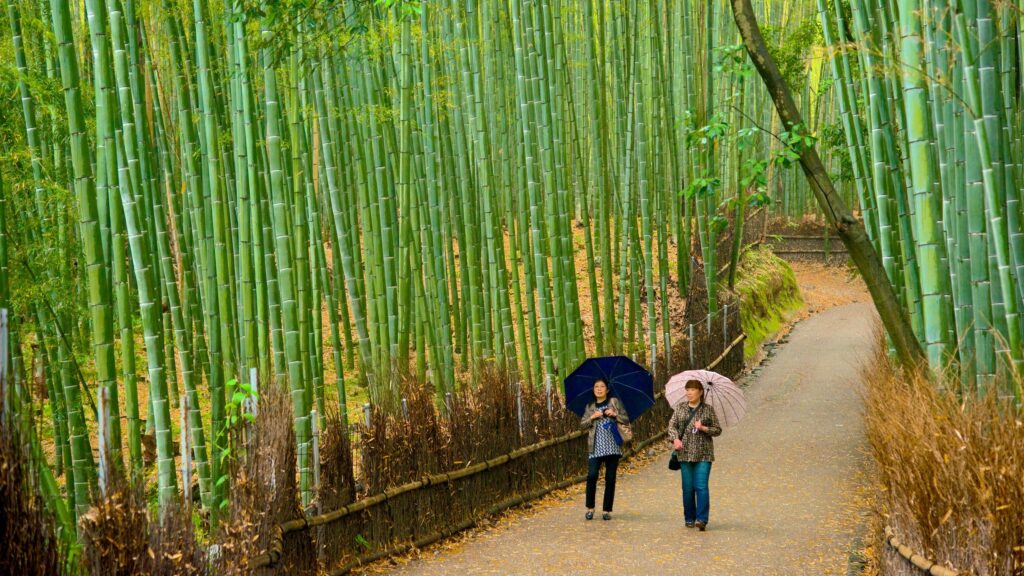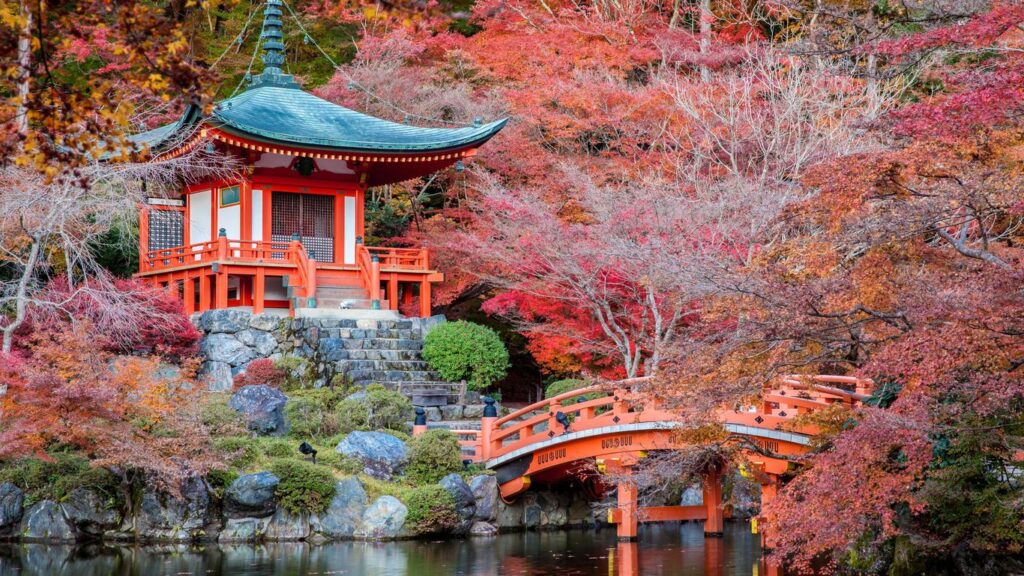Kyoto, a city that stands out as one of Japan’s most advanced in terms of culture, gastronomy, architecture, and economy. The proof of this city’s beauty lies in its frequent recognition as one of the world’s most beautiful cities. Kyoto has also served as the imperial capital of Japan for over a millennium, with its name in Japanese meaning “Capital of capitals.”
Surviving the ruthless and destructive bombs of the United States during World War II, Kyoto is one of the rare Japanese cities that remained intact. Due to its historical significance, the city is rich in religious diversity and hosts more than two thousand temples.
The silhouette of the city is enhanced by cherry blossoms and sakura trees. Kyoto boasts seventeen sites listed on the UNESCO World Heritage List. Surprisingly, one aspect of this significant city is the absence of an airport.
Legendary Places to Visit: Golden Pavilion and Arashiyama Bamboo Forest
Kyoto is one of Japan’s most famous tourist cities, offering a naturally outstanding route for history, culture, and tourism. Preserving its historical features and past culture, Kyoto can be described as the cultural center of Japan.
Temples, museums, sculptures, and paintings, the city presents art at every step. Kyoto is generous, offering different beauties every month throughout the year. While there are countless places to visit in this beautiful and legendary city, I would like to share a bit about the Golden Pavilion and Arashiyama Bamboo Forest.
One of the must-visit attractions in Kyoto is undoubtedly the Golden Pavilion. Built in 1394, the exterior of the pavilion is adorned with gold leaf. The Golden Pavilion suffered a major fire and was faithfully reconstructed in 1955. The golden color of the temple reflects on the lake beneath, creating a breathtaking view.
Arashiyama Bamboo Forest is one of the most beloved places for tourists. It is impossible not to be impressed by the rows of bamboo trees extending towards the sky in the peaceful silence. Visitors seeking tranquility encounter different beauties of this forest in every season.
Flavors of Traditional Japanese Cuisine
Japan holds a significant place in the world not only for its traditions, culture, and technology but also for its culinary culture and cuisine. Japanese cuisine is highly popular for its presentation and table manners, consistently sparking curiosity in people.
They base their food culture on the “5 Rules,” representing five different colors. Red, white, green, black, and yellow symbolize the use of natural foods with these colors in cooking. Here are the top 10 dishes of Japanese cuisine: sushi, miso soup, soba, tempura, kaiseki, yakitori, tsukemono pickles, udon, and sukiyaki.
Shinto Shrines and Buddhist Temples
Japanese culture is rooted in ancient traditions, intertwined with religious beliefs. There are various religions in the country, and followers of these religions worship in temples. From newly constructed temples to those built centuries ago, there is an abundance of temples in Japan. Let me introduce you to the captivating Shinto Shrines and Buddhist Temples.
Shinto Shrines adhere to the polytheistic teachings of Shintoism and are places of worship for Japanese adherents. There are around 80,000 Shinto Shrines throughout the country. Unlike temples built for other religions, Shinto Shrines are constructed with a simple architectural style and engineering that does not harm nature.
These shrines are built using wooden materials, mainly Japanese cypress, and are painted after completion. One unique feature is the absence of nails or similar fasteners, with wooden parts interlocking.
The walls are made of a mixture of bamboo and plaster, placed between the columns to form the walls. The most famous Shinto Shrines include Itsukushima Shrine, Toshogu Shrine, and Izumo Taisha Shrine, among others.
Buddhist Temples belong to Buddhism, one of Japan’s major religious beliefs. These temples can be quite large, with many featuring pagoda-shaped structures. Some are made of wood, while others are made of stone.
Wooden ones are typically constructed with two to five stories, with the smallest being around three meters tall. Incense, called senko, is often burned inside. These temples house numerous Buddhist statues, and doors play a crucial role in their architecture.
The most famous Buddhist Temples include Sensoji Temple, Kiyomizudera Temple, Todaiji Temple, Kinkakuji Temple, and Hasedera Temple. Of course, there are many more Buddhist Temples that could be added to this list.
Traditional Kimono Experience
Kimono is the name of the world-renowned traditional attire of the Japanese. It has been embraced to the extent that it is considered one of Japan’s symbols globally. This attire, used for approximately five centuries, has retained its form without undergoing significant changes.
The structure of the kimono resembles a robe, and it does not have buttons. The waist is wrapped with a fabric similar to a belt, called “Obi,” which has a special tying style. Despite its elegant appearance, wearing this attire is relatively easy.
The word “Kimono” translates to “Clothing.” Both women and men can wear these traditional garments. Although widely worn until World War II, the globalized world after the war led to a decline in the use of traditional attire in daily life. Today, it may be used for special ceremonies or weddings, with minimal usage in everyday life.
While the kimono may appear simple and single-layered, it is actually considered in many layers. Nagajuba is the lower part worn beneath the kimono. Erishin refers to the collar parts. The kimono is the main part that covers the entire body. Obi is the belt wrapped around the waist, and Obijime is a lace that can be placed over the belt. Tabi refers to traditional white socks, and Jori is the footwear worn under the kimono.
Hanami: Cherry Blossom Festival
Starting in late March and continuing until the first weeks of May, cherry blossoms bloom in Japan. The Cherry Blossom Festival, Hanami, is a celebration dedicated to these blossoming cherry flowers.
Hanami can be described as a tradition of welcoming spring that has been present in Japanese culture for centuries. As mentioned earlier, Japanese culture embraces many polytheistic elements. For this reason, they considered cherry blossoms sacred.
Farmers would pray to them after planting their fields, hoping for a bountiful harvest and increased productivity. This practice bestowed a kind of sanctity upon cherry blossoms. Compared to contemporary festivals, this festival is relatively simple.
People gather under the mesmerizing beauty of cherry blossoms, bringing their own food and drinks. The Japanese continue their festivities into the night, organizing events called “Yozakura.” Since these events take place at night, they enhance the beauty of the festival by hanging paper lanterns on the cherry blossoms. Yoyogi Park, Kinkakuji, and Sakuranomiya are among the best places to observe Hanami.
See you in the next post,
Anil UZUN


